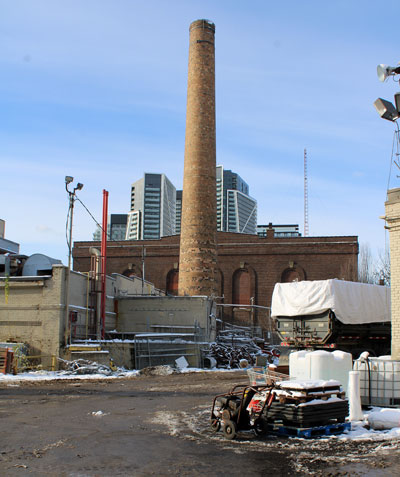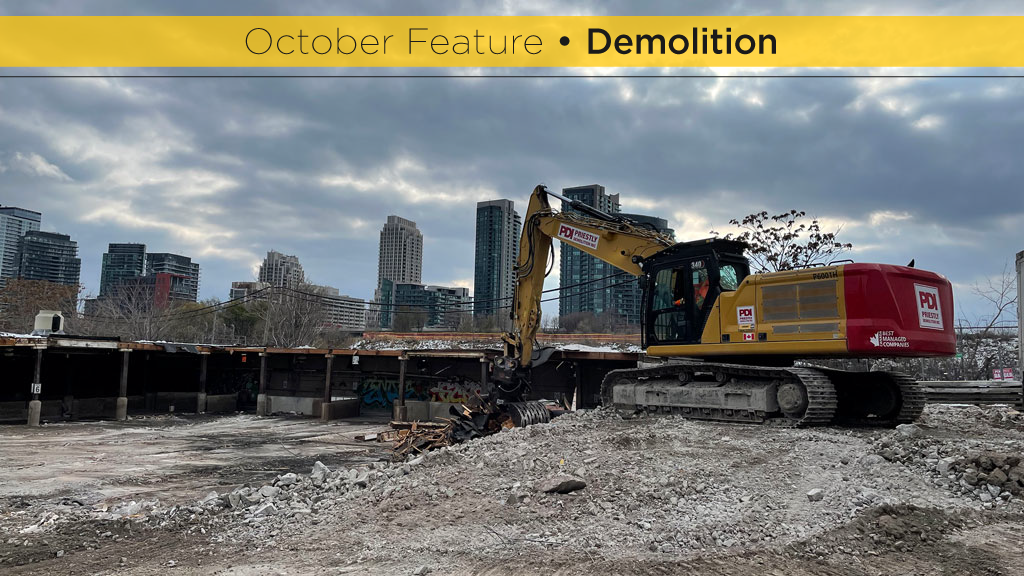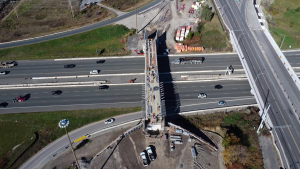A remnant of Toronto’s industrial past has been relegated to the history books almost a century or so after it was built and after it obtained the reputation in more recent times of being the source of numerous noise and odour complaints.
This past April contractor Priestly Demolition Inc. completed the demolition of an old abattoir at Two Tecumseth Drive in the west-end community of Liberty Village.
In its place an approximately 92,905-square-metre mixed-used development by TAS and Woodbourne Capital, known as The Yards, will emerge.
“We completed the work in a few short months for the new construction to start,” says Priestly project manager Mario Garcia, referring to the TAS development.
But there were more than a few challenges, including an extensive abatement process, protecting an adjacent heritage building, avoiding impacting the nearby GO train corridor, and an extremely tight schedule, he says.
Of course, those challenges started long before the official knockdown occurred.
A demolition engineering plan had to be filed with and reviewed by Metrolinx as the GO train line leads directly to Union Station and the trains which head there carry thousands of commuters daily.
Prepared by CSE (Carvajal Structural Engineers Inc.), the engineer of record on the demolition plan with City of Toronto, the plan was subject to periodic reviews by Priestly’s own engineering department.
The contractor came onsite in October 2022 and the first step was abatement, which included removing piping insulation, fire-related and other hazardous materials.
Just as extensive was the second stage, completed later in the fall, which entailed the complete strip out of architectural finishes and fixtures while the building envelope was still intact, says Garcia.
When it came to the actual demolition, an array of different machines was critical. Rather than a single structure, the abattoir was a conglomerate of the original century-old brick building and later additions built of steel and concrete.
“There was a multiple range of construction designs and materials that required different types of machines and procedures,” Garcia states.
For this project the onsite equipment required included a 50-ton excavator, a 75-ton high reach, a 90-ton reach, a rock crusher, and a range of other machines including four skid steers, and two, 20-ton rock trucks.
Unlike demolitions carried out in dense downtown settings, there was plenty of space to maneouvre the equipment. But it was still an urban site, with the inherent issues of dust control and traffic management, says Garcia.

“Keeping debris within our target area was a challenge and debris screens ran the entire length of the project where exposed to the transit corridor.”
When working in a city, managing traffic flow of heavy vehicles in and offsite is always a challenge. On the Two Tecumseth site there was a need for extensive traffic signs, and direction and safety procedures to ensure public safety as well as the crew.
“Moving material off-site was a constant ongoing process,” he adds.
Security cameras had to be set up, additional fencing erected and overnight lighting maintained because of concerns about looting of copper and other salvageable materials, he says.
Certainly, the project was distinguished by a very high material recycling rate. The fleet of heavy equipment included a crusher which crumpled 20,000 tons of concrete, all of which will be reused onsite for the new development, he says.
That 20,000-ton figure does not include 300 tons of concrete blocks and 600 tons of crushed concrete which will be used for architectural landscaping. Eighty skids of brick were also saved and will be incorporated into architectural finishes.
As well, 80 large wood timbers were saved for future use and, besides the concrete, a 100-per cent recycling rate for other materials such as metal, aluminum and electrical components was also reached, says Garcia.
“It is our company mission to lead the change to a more sustainable future and we are constantly looking for innovative ways to recycle and keep and material out of landfill,” said Garcia.
Another element of the project was the erection of screens and other extensive measures to safeguard the abattoir’s large stack, which will be incorporated into the TAS development. Those measures also included protecting the nearby historically significant Wellington Destructor. Although not technically part of the same property, the preservation and readaption of the 1920s red brick building is a major component of TAS’ vision for The Yards.
The workforce peaked at about 50 and the average throughout the demolition was 25, says Garcia.
As for The Yards project, construction is anticipated to start in early 2024 with the installation of a geothermal bore field which will prove the project’s environmental sustainability and climate resiliency, says TAS development manager Connor Gregory.




Recent Comments
comments for this post are closed